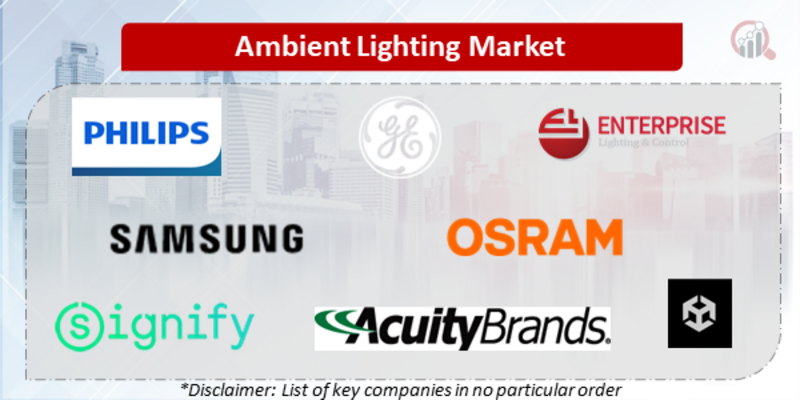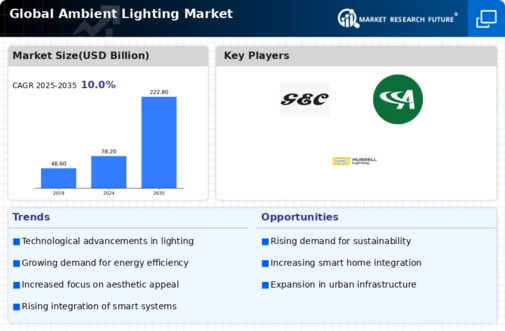Top Industry Leaders in the Ambient Lighting Market

The Competitive Landscape in the Ambient Lighting Market
The ambient lighting market, casting its glow on the home automation and interior design industries, fueled by a growing desire for comfortable, personalized, and energy-efficient lighting solutions. This burgeoning market presents a dynamic landscape where established giants, nimble innovators, and a kaleidoscope of technological advancements intertwine. Let's delve into the strategies of market leaders, the key factors driving market share analysis, the emergence of exciting new players, and the overall competitive scenario illuminating this captivating market.
Key Player:
- Philips Lighting Holding
- General Electric Company
- Enterprise Lighting LTD
- Unity Technologies SF
- OSRAM Licht
- Signify N.V.
- Acuity Brands
- Hubbell Lighting
- Samsung Electronics Co. Ltd.
- The Zumtobel Group
- Häfele GmbH & Co KG
Strategies Adopted by Leaders:
- Technological Diversification: Acuity Brands invests in multiple screenless display technologies like holographic and retinal interfaces, catering to a broader range of applications.
- Partnership Play: Microsoft collaborates with automotive giants to integrate holographic displays into car dashboards, while Google teams up with entertainment studios for immersive theatrical experiences.
- Content Creation Focus: Realview Imaging Ltd. focuses on developing 3D content libraries specifically formatted for holographic displays, creating a competitive edge.
- Vertical Specialization: Alphabet Inc.'s Project Soli focuses on gesture-based screenless interaction, catering to healthcare and industrial applications.
- Early-Mover Advantage: Established players like Microsoft and Sony leverage their brand reputations and existing customer base to gain a foothold in the market.
Factors for Market Share Analysis:
- Technology Leadership: Companies with proprietary screenless display technologies and advanced projection systems, like Sony's Spatial Reality Display, command premium pricing and secure market share by offering superior visual experiences.
- Content Ecosystem Development: Access to or creation of compelling 3D content for various applications like retail, advertising, and entertainment empowers companies to attract and retain customers.
- Regulatory Landscape: Navigating and adhering to complex regulations surrounding safety and health impacts of specific screenless display technologies like retinal interfaces holds strategic significance.
- Investment Potential: Companies with strong R&D capabilities and proven ability to attract venture capital or public funding are better positioned to fuel technological advancements and secure market share.
- Regional Focus: Asia-Pacific, with its strong tech adoption and focus on immersive experiences, leads in market size and growth potential, demanding regional customization strategies.
New and Emerging Companies:
The market is witnessing an influx of exciting startups and research institutions eager to disrupt the established order and illuminate new possibilities. Examples include LIFX, developing color-changing LED bulbs with circadian rhythm control, and Nanoleaf, focusing on modular LED panels for interactive and immersive lighting experiences. These new entrants, with their fresh perspectives and innovative technologies, are expected to further accelerate the pace of innovation and broaden the market's reach.
Industry Developments:
Philips Hue:
-
Dec 2023:Launched Philips Hue Sync TV, immersing viewers in synchronized lighting effects based on on-screen content.
Lutron Electronics:
- Nov 2023: Released Palladiom Collection, a line of luxury smart dimmers and switches for high-end homes.
